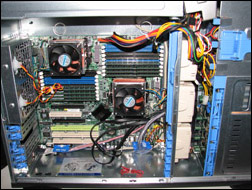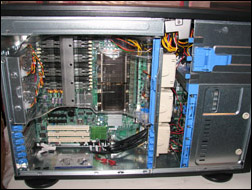AMD Socket-F Opteron vs. Intel Woodcrest
by Jason Clark & Ross Whitehead on December 18, 2006 12:05 AM EST- Posted in
- IT Computing
Socket-F System
The Socket-F system has two 2.6GHz (2218) processors mounted on a Tyan S3992 main board, with 8x1GB of DDR2-667 OEM memory. Internal cooling consists of five 3.5" fans and two CPU fans. Internal storage is provided by two WD1600YD hard drives configured in RAID 0, which is where the OS is installed.
Opteron 285 System
The Opteron 285 system consisted of a Tyan S2891 motherboard and 8 x 1GB of PC3200 DDR memory. We powered the 285 out of the Socket-F case, to keep the power measurements accurate. Internal cooling was identical to the Socket-F system, as the motherboard was placed inside the Socket-F system. The internal drives from the Socket-F were also used, to keep the measurements identical.
Woodcrest System
The Woodcrest system is configured with two 3.0GHz Xeon 5160 processors, seated in a SuperMicro X7DBE+. We also swapped out the processors and tested with two Xeon 5150 (2.66GHz) CPUs to provide a second reference point. The Woodcrest system is outfitted with 8x1GB 667 MHz OEM FB-DIMMS. Internal cooling consists of five 3.5" fans, with plastic ducting directing airflow across the CPUs and FB-DIMMs (shown below). Internal storage once again comes from two WD1600YD hard drives configured in RAID 0 with the OS installed.
RAID Storage
LSI Logic 8480E MegaRaid Controller
Promise VTRAK J300s SAS Chassis
12 x 146GB Fujitsu 15,000 RPM SAS Drives configured in RAID 0
Operating System/Software
Windows 2003 Enterprise SP1 x64
SQL 2005 Enterprise x64
Test Client
Dual Opteron 285 with 8GB of memory.
The Socket-F system has two 2.6GHz (2218) processors mounted on a Tyan S3992 main board, with 8x1GB of DDR2-667 OEM memory. Internal cooling consists of five 3.5" fans and two CPU fans. Internal storage is provided by two WD1600YD hard drives configured in RAID 0, which is where the OS is installed.
Opteron 285 System
The Opteron 285 system consisted of a Tyan S2891 motherboard and 8 x 1GB of PC3200 DDR memory. We powered the 285 out of the Socket-F case, to keep the power measurements accurate. Internal cooling was identical to the Socket-F system, as the motherboard was placed inside the Socket-F system. The internal drives from the Socket-F were also used, to keep the measurements identical.
Woodcrest System
The Woodcrest system is configured with two 3.0GHz Xeon 5160 processors, seated in a SuperMicro X7DBE+. We also swapped out the processors and tested with two Xeon 5150 (2.66GHz) CPUs to provide a second reference point. The Woodcrest system is outfitted with 8x1GB 667 MHz OEM FB-DIMMS. Internal cooling consists of five 3.5" fans, with plastic ducting directing airflow across the CPUs and FB-DIMMs (shown below). Internal storage once again comes from two WD1600YD hard drives configured in RAID 0 with the OS installed.
 Socket-F Server |
 Woodcrest Server |
| Click to enlarge | |
RAID Storage
LSI Logic 8480E MegaRaid Controller
Promise VTRAK J300s SAS Chassis
12 x 146GB Fujitsu 15,000 RPM SAS Drives configured in RAID 0
Operating System/Software
Windows 2003 Enterprise SP1 x64
SQL 2005 Enterprise x64
Test Client
Dual Opteron 285 with 8GB of memory.










38 Comments
View All Comments
proteus7 - Monday, December 18, 2006 - link
Not sure how the conclusion that Socket-F wins is reached.True performance benchmarking can only occur with CPU as close as possible to 100%, and NO other benchmarks in the system. For a TPC-C style OLTP database workload for example, usually about 400+ HDDs would be required on a 4-core system to ensure this, and a lot more memory (16GB minimum would be realistic for 4-cores).
In every benchmark posted, at full load, Woodcrest wins. If you try to spin "load points", "perf per watt", etc, it then muddies the waters.
Finally, you should put a disclaimer that this test is for a very specific workload. The good news is that there was no deliberate attempt to skew the results towards AMD. If so, you would have picked a large OLAP, DSS, or Data Warehouse type workload, which take better advantage of Socket-Fs superior memory latency on out-of-cache workloads.
JarredWalton - Monday, December 18, 2006 - link
Actually, Woodcrest isn't the clear winner. It is faster, at a higher power draw, and there are reportedly situations where Opteron will still come out with a (sometimes significant) lead. We didn't test such situations here, but a "clear win" would be what we see on the desktop where Core 2 Duo is typically faster than any X2 processor while using less power - although the power situation is still somewhat up for debate.I know I worked in a data center for several years where we had at least 12 servers. I don't think any of those servers was running at more than about 25% capacity, so there are definitely companies that aren't going to care too much about performance at maximum load. Of course, it's kind of funny that the data center I worked at was a 100% Dell shop (at least for desktops, laptops, and non-UNIX servers), so all of the servers were running the Xeon DP/MP processors during a time where Opteron was clearly providing better performance and lower power requirements.
mlittl3 - Monday, December 18, 2006 - link
Jarred,I think the problem with many of these comments questioning the conclusions of the article is that not many people understand how enterprise level workstation and servers are bought and used. It would be nice if Anandtech did an article about some company that uses a lot of workstation and servers and go through their thought process when it comes to what hardware to buy. Then the article could go into how the servers manage workloads and what factors are important (performance, power, stability, etc.).
Too many readers here think that a server cluster is bought as soon as new hardware is released and that these enterprise level IT professionals go to hardware review sites and see which hardware has a better 3dmark score. This is of course not the case.
Strunf - Tuesday, December 19, 2006 - link
I think it’s pretty common knowledge how companies get their systems, I mean after Intel owning so much with the crap they had, it’s pretty obvious that performance and power consumption are secondary... but articles have to stay objective because no one knows what the deals between companies and the OEMs really “hide”...“Too many readers here think that a server cluster is bought as soon as new hardware is released...”
Actually I would say many server clusters are bought at the same time new hardware is released...
mino - Wednesday, December 20, 2006 - link
"Actually I would say many server clusters are bought at the same time new hardware is released..."Yeah, they are. The purchase is mostly waiting for the certain speed-bump in architecture/design to appear...
chucky2 - Thursday, December 21, 2006 - link
I work in IT as a PM at what is the probably now the largest telecomm in the US - not on a standards committee, purchaser, or operations person who actually sets the hardware up - and at least for the boxes that host the services my org cares for, I know the hardware folks don't like to see any one of them go over 50% CPU or RAM utilization, and that's simply because of failover.If a machine in a cluster goes down, the other machine(s) are expected to pick up that load and not incurr downtime...downtime is bad. You could have .003% downtime <i>just for one small but main part of IT (like mine) </i> for a <b>quarter</b> and that might equate into a million dollars lost.
Hardware is not necessairly ordered when new hardware is released...in fact, that's more than likely not the case. New hardware is not necessairly tested and proven hardware. Just because the parts folks (Intel, AMD, whoever) and the vendors (IBM, Sun, HP, whoever) are selling it, doesn't mean it stable, or at least proven to work for what a company is going to use it for. When the expectation is 100% uptime except for maintenance periods, you want your standards folks to have tested the stuff everyone in the company will be allowed to order...or at least have them looked over the changes to whatever the company standard is and say, OK, that's an acceptable upgrade, we're comfortable with that change.
So, No, ordering the latest and greatest hardware when it comes out it not really the smart way to do things when you're talking about reliability...and the same goes for software...putting on the latest AIX or Oracle or JRE patch/version almost never happens. It's the same thing there, unless there's an absolute need for that specifc hardware/software, then you go with tried and true, because that's what's delivering <i>for sure</i>.
The above is most likely why AMD had such a hard time breaking into the Enterprise sector...they had to prove that their hardware could get the job done as reliably as Intel, Sun, and IBM. Now that they have, hopefully the major Enterprise folks will give them more consideration...with as good as Operteron has been, they deserve it.
Chuck
LoneWolf15 - Monday, December 18, 2006 - link
Are pages three and four supposed to have tables/graphs? I'm getting two paragraphs of text on each page using Firefox 2.0, and that's it. Seems like there'd be more under your testing methodology.Jason Clark - Monday, December 18, 2006 - link
Yep, I was fixing something in the article and juggling pages around. Should be ok now.LoneWolf15 - Monday, December 18, 2006 - link
Still doesn't look right. Paragraph formatting is really off, and there's a couple of HTML tags showing. Makes it kind of hard to read.LoneWolf15 - Monday, December 18, 2006 - link
That's on Page 3 btw. Page 4 now looks fine.